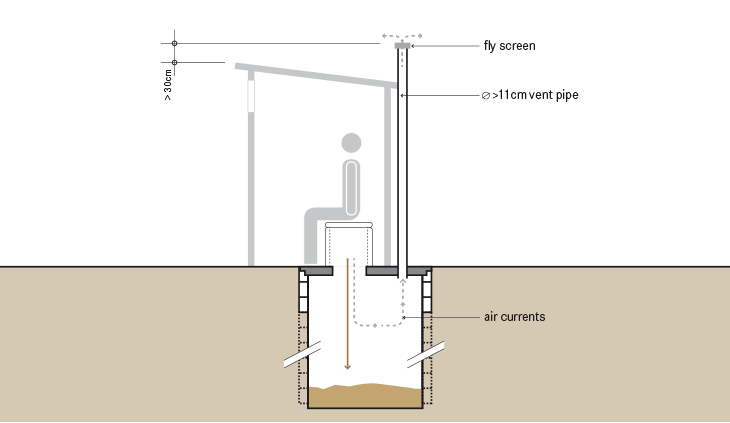
Executive Summary
The single VIP is a ventilated improved pit. It is an improvement over the single pit because continuous airflow through the ventilation pipe vents odours and acts as a trap for flies as they escape towards the light.
| In | Out |
|---|---|
| Urine, Faeces, Excreta, Blackwater, Anal Cleansing Water, Dry Cleansing Material |
Sludge |
Introduction
Despite their simplicity, well-designed single VIPs can be completely smell free, and more pleasant to use than some other water-based technologies.
Flies that hatch in the pit are attracted to the light at the top of the ventilation pipe. When they fly towards the light and try to escape, they are trapped by the fly-screen and die. The ventilation also allows odours to escape and minimizes the attraction for flies.
Design Considerations
The vent pipe should have an internal diameter of at least 110 mm and reach more than 300 mm above the highest point of the toilet superstructure. Wind passing over the top creates a suction pressure within the vent pipe and induces an air circulation. Air is drawn through the user interface into the pit, moves up inside the vent pipe and escapes into the atmosphere. Care should be taken that objects, such as trees or houses, do not interfere with the air stream. The vent works best in windy areas, but where there is little wind, its effectiveness can be improved by painting the pipe black. The heat difference between the pit (cool) and the vent (warm) creates an updraft that pulls the air and odours up and out of the pit. To test the efficacy of the ventilation, a lit cigarette can be held over the user interface; the smoke should be pulled down into the pit and up into the vent and not remain in the superstructure.
The mesh size of the fly screen must be large enough to prevent clogging with dust and allow air to circulate freely. Aluminium screens, with a hole-size of 1.2 to 1.5 mm, have proven to be the most effective. Typically, the pit is at least 3 m deep and 1 to 1.5 m in diameter, depending on the number of users. Deep pits can last up to 20 or more years.
As liquid leaches from the pit and migrates through the unsaturated soil matrix, pathogenic germs are sorbed to the soil surface. In this way, pathogens can be removed prior to contact with groundwater. The degree of removal varies with soil type, distance travelled, moisture and other environmental factors and, thus, it is difficult to estimate the distance necessary between a pit and a water source. A minimum horizontal distance of 30 m between a pit and a water source and 2 m between the bottom of the pit and the groundwater table is normally recommended to limit exposure to microbial contamination.
When it is not possible to dig a deep pit or the groundwater level is too high, a raised pit can be a viable alternative: the shallow pit can be extended by building the pit upwards with the use of concrete rings or blocks. A raised pit can also be constructed in an area where flooding is frequent in order to keep water from flowing into the pit during heavy rain.
A single VIP toilet can be upgraded to a double VIP. A double VIP has an extra pit so that while one is in use, the contents of the full pit are allowed to drain, mature and degrade.
If a urine-diverting user interface is used, only faeces are collected in the pit and leaching can be minimised.
Health Aspects/Acceptance
A single VIP can be a very clean, comfortable, and well accepted sanitation option. However, some health concerns exist:
- Leachate can contaminate groundwater;
- Pits are susceptible to failure and/or overflowing during floods;
- Health risks from flies are not completely removed by ventilation.
Operation & Maintenance
To keep the single VIP free of flies and odours, regular cleaning and maintenance is required. Dead flies, spider webs, dust and other debris should be removed from the ventilation screen to ensure a good flow of air.
Treatment processes in the single VIP (aerobic, anaerobic, dehydration, composting, or otherwise) are limited, and, therefore, pathogen reduction and organic degradation is not significant. However, since the excreta are contained, pathogen transmission to the user is limited. This technology is a significant improvement over single pits or open defecation.
Single VIPs are appropriate for rural and peri-urban areas; in densely populated areas they are often difficult to empty and/or have insufficient space for infiltration. VIPs are especially appropriate when water is scarce and where there is a low groundwater table. They should be located in an area with a good breeze to ensure effective ventilation. They are not suited for rocky or compacted soils (that are difficult to dig) or for areas that flood frequently.
The design of Ventilated Improved Pit Latrines
The purpose of this paper is to discuss general design criteria for VIP latrines and to review recent developments in VIP latrine design.
MARA, D.D. (1984): The design of Ventilated Improved Pit Latrines. UNDP Interregional Project. (= United Nations Development Programme Interregional Project , 47 ). Washington: The World Bank URL [Accessed: 11.10.2013]Low-cost Urban Sanitation
This book covers the public health, technical, socioeconomic, sociocultural and institutional aspects of sanitation in towns and cities of developing countries. The text features excreta-related diseases and the use of sanitation to reduce their transmission. The sanitation technologies covered in detail are VIP latrines, pour-flush toilets, septic tanks, settled sewerage and simplified sewerage, with additional chapters on sullage disposal, pit emptying, and sewage treatment and reuse. Sociocultural constraints on sanitation systems and their socioeconomic costing are described, together with hygiene education, which is essential in order to achieve maximum benefits to health. The text also explains how to choose the most appropriate sanitation option for a given low-income community. Finally, institutional aspects are reviewed, including effective sanitation programme planning, monitoring and evaluation.
MARA, D. (1996): Low-cost Urban Sanitation. United Kingdom: WileyEcological Toilets
This book describes how to construct Arborloo toilets and how it can be upgraded to VIPs at a later stage.
MORGAN, P. EcoSanRes (2009): Ecological Toilets. (pdf presentation). Stockholm: Stockholm Environment Institute URL [Accessed: 09.05.2019]The Upgradeable Blair VIP
This manual provides detailed design and construction information on the Blair VIP toilet.
MORGAN, P.P. (2011): The Upgradeable Blair VIP . Manual for upgradeable BVIP model with spiral superstructure and tubular vent. Stockholm: Stockholm Environment Institute (SEI) URL [Accessed: 31.01.2014]Ventilated Improved Pit Latrines: Vent Pipe Design Guidelines
This technical note sets out preliminary guidelines for the design and construction of vent pipes for ventilated improved pit (VIP) latrines.
RYAN, B.A. MARA, D.D. (1983): Ventilated Improved Pit Latrines: Vent Pipe Design Guidelines. (= UNDP Interregional Project INT/81/047 ). Washington: The World Bank, United Nations Development Programme (UNDP) URL [Accessed: 31.01.2014]

